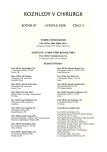Initial Results of the Bipolar RFITT Coagulation in Advanced Stages of Hemorrhoidal Disorder Study
Authors:
J. Duben; L. Hnátek; B. Dudešek; T. Musil; J. Gatěk
Authors‘ workplace:
Chirurgické oddělení Nemocnice Atlas a. s., Univerzita Tomáše Bati ve Zlíně, prim. MUDr. Jiří Gatěk, Ph. D.
Published in:
Rozhl. Chir., 2008, roč. 87, č. 11, s. 576-579.
Category:
Monothematic special - Original
Overview
Aim of the Study:
The aim is to verify a new methodology of radiofrequency bipolar coagulation for treatment of hemorrhoids in practice.
Used Methods:
The method of bipolar radiofrequency- induced thermotherapy of internal and external hemorrhoids using the Olympus Celon apparatus. Radiofrequency bipolar electrode was applied to perform coagulation of internal and external hemorrhoids under visual control and feedback. RF energy was applied, on average, at 12 sites above the dentate line to treat internal, stage III hemorroids. In stage IV hemorrhoids, based on the prolapse extent, it was applied to external hemorrhoids, as well. In four subjects, the method was used in combination with a standard Parks management to perform excision of perianal fibromas.
Results:
From September 2007 to June 2008, the method was used in 18 patients with stage III and IV hemorrhoids. 15 patients underwent a per- protocol follow up on postoperative Day 7 and Day 21. Then, the first 5 subjects were checked in a 6- month interval and will be re-assessed in 12 months. The average duration of the procedure was 20 minutes and duration of hospitalization was 24 hours. Postoperative bleeding lasted for average 0–10 days. Major postoperative edema occured in 2 subjects. The average pain intensity (on 0-10 scale) was 1.5 on Day 7; 0.46 on Day 21. The postoperative complications included anal fissures with increased pain intensity in 2 subjects with a preoperative history of anal procedures. Transient edema of external hemorrhoids occured upon management of the stage IV hemorrhoidal disorder.
Conclusion:
Bipolar radiofrequency- induced thermotherapy of hemorrhoids is a new, semiinvasive method of the management of hemorrhoids. It is safe, with minimal rates of early postoperative complications. It is well- tolerated and evaluated by patients. Long-term results will be published further.
Key words:
hemorrhoids – radiofrequency – thermoregulation – RFITT
Sources
1. Herold, A. Terapie Des Hämorhoidalleidens. Chirurg, 2006, 77, 8: 737–747.
2. Jech, Z. Současné možnosti léčby hemoroidální nemoci. Med. Pro Praxi, 2006, 6: 284–287.
3. Hnátek, L. Miniinvazivní terapie křečových žil. Medical Tribune, ročník III, číslo 27, 24. Září 2007.
4. Hnátek, L., Duben J., Dudešek, B., Musil, T.. Gatěk, J. Endovaskuläre Radiofrequenzablation der Krampfadern. Phlebologie, 2007, 36, 4: 5–22.
5. Hnátek, L., Duben, J., Sternberský, J., et al. Die Rolle der miniinvasiven chirurgischen Verfahren während der Behandlung von Patienten mit CVI im Stadium C5 und C6. Phlebologie, 2007, 36 4: 5–22.
6. Camci, M., Harnoss, B., Akkersdijk, B., Braithwaite, B., Hnátek, L., et al. Bipolare Radiofrequenz-induzierte Thermotherapie (RFITT) zur effizienten und schonenden Behandlung insuffizienter Venen: Ergebnisse der BRITTIV Multicenter-Studie. Phlebologie, 2007, 36, 4: 5–22.
7. Hnátek, L., Duben, J.,Dudešek, B., Gatěk, J. Endoluminální radiofrekvenční ablace křečových žil, Rozhl. Chir., 2007, roč. 86, č. 11, s. 581–585.
8. Duben, J. Zkušenosti s operací hemoroidů pomocí RFITT. Medical Tribune, roč. IV, 21, A8, červen 2008.
9. Gupta, J. A New Instrumental Procedure for Non-prolapsing Hemorhoidal Disease.
10. Gupta, J. Radio-ablation of advanced grades of hemorrhoids with radiofrequency. Current Surgery, Volume 60, Issue 4, Pages 452–458.
11. Gupta, J. P. Randomized Trial Comparing In-Situ Radiofrequency Ablation andMilligan-Morgan Hemorrhoidectomy in Prolapsing Hemorrhoids. Journal of Nippon Medical School, Vol. 70 (2003), No. 5, pp. 393–400.
12. Pfeninger, J. Modern treatments for internal haemorrhoids. BMJ, Vol. 314, 1997, 1211–1212.
13. Kirsch, J. J. Ambulante Hämorrhoidenbehandlung – Nutzen und Risiko, Ergebnise bei 16.349 Patienten. Aktuelle Chir., (1989) 24: 253.
14. Morinaga, K., Hasuda, K., Ikeda, T. A novel therapy for internal hemorrhoids : ligation of the hemorhoidal artery with a newly devised instrument (Moricorn) in conjunction with a Doppler flowmeter. Am. J. Gastroenterol., (1995) 90: 610.
15. Bursics, A., Moravy, K., Kupcsulik, P. Comparison of early and 1-year follow-up results of conventional hemorrhoidectomy and hemorrhoid artery ligation: a randomized study. J. of Col. Dis., Vol. 19, 2: 176–180, 2004.
16. Longo, A. Treatment of hemorhoids disease by reduction of mucosa and hemoroidal prolapse with a circular suturing device: a new procedure In: Proccedings of the 6th World Congress of Endoscopic Surgery and 6th International Congress of European Association for Endoscopic Surgery (EAES), Rome, Italy, 1998.
Labels
Surgery Orthopaedics Trauma surgeryArticle was published in
Perspectives in Surgery

2008 Issue 11
- Metamizole vs. Tramadol in Postoperative Analgesia
- Metamizole at a Glance and in Practice – Effective Non-Opioid Analgesic for All Ages
- Possibilities of Using Metamizole in the Treatment of Acute Primary Headaches
Most read in this issue
- The Use of Biodegradable Materials in the Management of Bone Cysts in Children
- Biliary Ileus – Potential Complication of Cholecystolithiasis
- Operation Treatment of the Humeral Shaft Fractures
- Minimally Invasive Surgery in the Czech Republic
